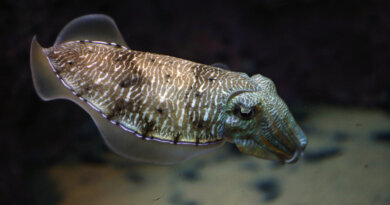Why Are My Dog’s Eyes Red Or Bloodshot? Causes (Allergies, Pink Eye, & More), Symptoms (Discharge, Swelling, Watery, Goopy) & Treatment
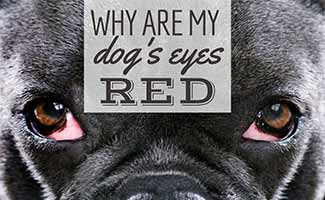 Have you noticed that your dog’s eyes are red in the whites of his eyes? There are many causes for this — some are minor, while other reasons could be a serious health concern that requires prompt veterinary attention.
Have you noticed that your dog’s eyes are red in the whites of his eyes? There are many causes for this — some are minor, while other reasons could be a serious health concern that requires prompt veterinary attention.
Our experts have compiled a guide to common dog eye issues that cause redness, swelling, and other symptoms to help you understand what your pup might be suffering from.
Article Overview
Why Do Dogs’ Eyes Get Red?
There are many causes for red eyes in dogs. We’ve highlighted the most common dog eye problems below. But underlying health conditions, like diabetes, hyperthyroidism, and some cancers, can also cause red eyes. So it’s important to consult with your veterinarian to get a proper diagnosis, especially if your dog has chronic red eyes.
Possible Causes
These are some of the common causes of red eyes in dogs, but your vet may have a different or more specific diagnosis.
Irritation
Your dog’s red eye could simply be an irritation to a foreign object, like dirt, dust, or grass, that has gotten into his eye. Other minor irritants like smoke, cleaning sprays, and perfumes can also cause temporary redness in your dog’s eyes.
Symptoms
- Eye redness
- Tears or watery discharge
- Itchy eyes (pawing at his eyes or rubbing his face)
Treatment
A mild irritation will usually clear up on its own, so check your dog’s eyes after a couple of hours to see if the redness is gone. If you’re concerned, give your vet’s office a call. They may suggest rinsing your dog’s eye out with lukewarm water to flush out the irritant. If redness persists after a day, it’s best to schedule an appointment with your vet.
Allergies
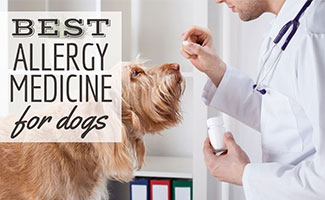
Symptoms
- Eye redness
- Tears or watery discharge
- Itchiness in eyes and/or skin
- Excessive scratching and licking of the skin
- Red or inflamed skin
- Hair loss
- Sneezing
Treatment
Dog allergies are best handled by your veterinarian, who can help you determine what’s causing his allergies and treat the specific cause appropriately. Don’t try to give your dog over-the-counter allergy medicine without first consulting with your vet.
Dog Allergy Testing
If you suspect allergies may be the culprit of your dog’s red eyes, these at-home dog allergy tests may give you some answers. These kits test for a wide variety of environmental factors and food ingredients that your dog may not tolerate well. Once you get the results, you should consult with your vet about any treatment options.
Injury
Dogs play hard, and this means they could end up injuring their eyes. A ball could accidentally hit your dog’s eye, or he could poke his eye with a stick.
Symptoms
- Whites of eyes are red
- Swelling and reddening of the eyelid and area around the eye
- Tears or watery discharge right after the incident
- Squinting
Treatment
If you think your dog’s eye was injured, consult with your vet to make sure your dog’s cornea wasn’t scratched. Minor eye injuries typically clear up within 24 hours. If redness and swelling continue, make sure you call your vet.
Pink Eye

Symptoms
- Red or puffy eyes
- Clear, watery eye discharge
- Goopy eye discharge with mucous that could be yellowish or greenish
- Red, swollen eyelids
- Squinting or excessive blinking
Treatment
Pink eye should be diagnosed and treated by your veterinarian. They can determine whether it’s infectious, which would require prescription eye drops to reduce inflammation, fight infection, and, if necessary, stimulate tear production. If the cause is viral or bacterial, your vet may also need to prescribe another medication to treat the underlying condition.
Dry Eye
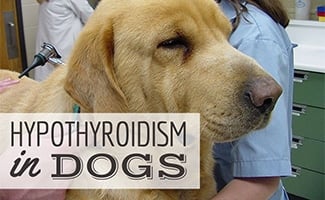
Some breeds are more likely to develop dry eye, including:
Symptoms
- Painful, red eyes
- Thick, yellowish, mucoid discharge
- Squinting, excessive blinking, or holding the eyes shut
Treatment
Your vet will test your dog’s eyes to determine the level of moisture the tear glands are producing. Vets usually prescribe special moisturizing eye drops for you to give your dog once or twice a day. They also recommend gently cleaning the eyes several times a day with a warm, wet washcloth to help relieve pain and to stimulate tear film production.
Your vet may also check for corneal ulcers, which commonly occur with dry eye. In many dogs, dry eye is a chronic, lifelong condition.
Glaucoma
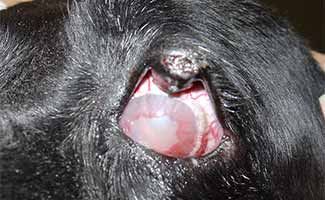
There are two types of glaucoma: primary (inherited) glaucoma and secondary glaucoma, which is caused by another condition such as injury, infection, cancer, uveitis, or retinal detachment.
Some popular breeds that are more prone to inherited glaucoma include:
- Basset Hound
- Beagle
- Chow Chow
- Cocker Spaniel (American and English)
- Norwegian Elkhound
- Poodle
- Siberian Husky
Symptoms
- Bloodshot whites of the eyes
- Cloudy eyes (sometimes with a bluish tint)
- Swollen or bulging eyes
- Watery discharge
- Dilated pupils
- Poor vision
- Pain
Treatment
If your vet suspects glaucoma, you may be referred to a veterinary ophthalmologist. They use a tool called a tonometer to measure the pressure within the eye (intraocular pressure).
In less severe cases, vets prescribe medications that decrease fluid production and promote drainage to treat the increased pressure. In severe or advanced cases (where there’s already optic nerve damage), dogs may require surgery to improve fluid drainage.
Cataracts

Dogs (and humans) can develop a cataract in one or both eyes, but the condition is frequent in both eyes. There are several causes of cataracts in dogs, including age, trauma, metabolic diseases such as diabetes, and genetics.
Some popular breeds that are more susceptible include:
- American Cocker Spaniel
- Boston Terrier
- Golden Retriever
- Miniature Poodle
- Miniature Schnauzer
- Siberian Husky
Symptoms
- Cloudy white or gray film over the center of the eye lens
- Chronic eye redness
- Eye socket inflammation
- Bulging of one eye compared to the other
- Noticeable vision problems, especially in dimly lit conditions
- Squinting
- Pawing at eyes
Treatment
If your vet suspects cataracts, you may be referred to a veterinary ophthalmologist. There are limited medications, including topical eye ointments or eye drops, which can postpone the need for surgery, but cataracts will not go away without surgery. Cataracts in dogs can progress rapidly, so it’s important to get your dog treated.
Uveitis
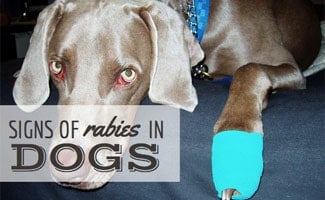
Common causes are viral infections (rabies, distemper), bacterial infections (Lyme disease, leptospirosis), parasitic infections (toxoplasmosis, ehrlichiosis), fungal infections (blastomycosis, histoplasmosis, cryptococcosis, coccidioidomycosis), metabolic disease (such as diabetes), high blood pressure, autoimmune diseases, toxins that get into the eye, trauma, and tumors.
Symptoms
- Eye redness
- Discharge
- Squinting
- Avoiding bright light
- Cloudy or dull eyes
Treatment
Veterinary treatment depends on the cause of uveitis and could include prescription eye drops, oral medications, eye ointments, and pain relievers. Your veterinarian will likely run diagnostic tests to narrow down the cause and treat the underlying condition.
Cherry Eye
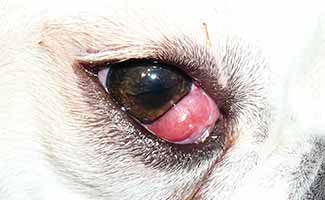
All dogs have a third eyelid that normally stays hidden in the inner corner of the eye. However, some dogs have a genetic disorder that weakens the fibrous attachment holding the third eyelid gland in place. This causes the eyelid to bulge in the inner corner of the eye. Cherry eye (technically called prolapse of the third eyelid gland) is rarely seen in dogs over two years old.
Popular breeds that are most commonly affected include:
- Basset Hound
- Beagle
- Bloodhound
- Boston Terrier
- Bulldog
- Cocker Spaniel
- Lhasa Apso
- Shih Tzu
Symptoms
- Pink or red bulge in the inner corner of the eye
- Inability to close the eye
- Pawing or rubbing at the eye
Treatment
Treatment of cherry eye involves surgical replacement of the third eyelid gland. Sometimes, the best surgical option is to remove the third eyelid gland, but dry eye could develop as a result. Your vet will discuss the best surgical technique for your pup.
It’s important to treat cherry eye as soon as possible to minimize permanent damage to the eye or the third eyelid gland. The third eyelid gland produces up to 50% of the watery (aqueous) portion of the eye’s tear film. Without this tear production, your dog is likely to develop dry eye, which can impair vision.
How Pet Insurance Can Help You And Your Dog
Get 4 Free Pet Insurance Quotes
Eye problems in dogs — and especially in some breeds — are very common. Vet bills, medications, and surgical procedures can get expensive. You may want to consider signing up for pet insurance as a proactive measure to lower your financial risk for potential health threats during your dog’s lifetime.
Why? Pet insurance is one of the best things you can do for your dog — not only for the health of your pup, but to save you from financial trouble should an accident, illness, or pet emergency arise. But keep in mind, pet insurance doesn’t cover pre-existing conditions, so the earlier you purchase a pet insurance policy for your dog the more likely to have any future diagnoses covered.
Humans have health insurance, so our furry friends should too. That way, you’ll never have to choose between an expensive treatment and your pet’s suffering or even his life. Pet insurance gives you peace of mind, so you can make better and less emotional decisions in the face of a crisis.
Check out our comparison of the top three pet insurance providers to learn more.
Frequently Asked Questions
Here are some of the questions our readers ask. Don’t see yours here? Ask us in our comment section, and our experts will help you out.
What If It’s Red Around My Dog’s Eyes?
If your dog’s eyelids are red and swollen, it could be a condition called blepharitis, which is an inflammation of the eyelids. Blepharitis can be caused by allergies, infections, congenital abnormalities, tumors, or inflammatory disorders. If your dog’s eyelids are red and swollen, it’s best to get him checked by your veterinarian.
What If There’s A Red Spot In My Dog’s Eye?
If you notice a small red spot in your dog’s eye, it could just be a minor broken blood vessel. This usually isn’t a cause for concern and should clear up on its own. However, if you notice several blood clots in the front of the eye or any other changes to your dog’s eye or vision, you should seek veterinary attention as soon as possible.
Is There A Home Remedy To Treat Dog Red Eyes?

How To Clean Your Dog’s Eyes
Do your dog’s eyes often get goopy? Check out this video from a professional dog groomer for some tips on how to clean your dog’s eyes at home (and how to make it comfortable for your pup). Again, it is recommended to check with your vet before treating your dog’s eyes at home.
Protecting Your Dog’s Eyes From The Elements
If you take your dog on outdoor adventures (camping, hiking, etc.) or on long car rides where he has his head out of the car window, you may want to protect your dog’s eyes from the sun, wind, debris, and other elements that could affect his eyes. See our reviews of the best dog goggles for our product recommendations.
Has your dog ever suffered from an eye problem?


